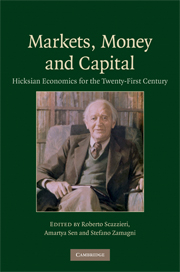Book contents
- Frontmatter
- Contents
- List of figures
- List of tables
- List of contributors
- Preface and acknowledgments
- Between theory and history: on the identity of Hicks's economics
- Part I The Intellectual Heritage of John Hicks
- Part II Markets
- Part III Money
- Part IV Capital and Dynamics
- 15 ‘Distribution and Economic Progress’ after seventy years
- 16 Flexible saving and economic growth
- 17 The economics of non-linear cycles
- 18 A perspective on a Hicksian non-linear theory of the trade cycle
- 19 Capital, growth, and production disequilibria: on the employment consequences of new technologies
- 20 Capital and time
- 21 Sequential analysis and out-of-equilibrium paths
- References
- Name index
- Subject index
18 - A perspective on a Hicksian non-linear theory of the trade cycle
Published online by Cambridge University Press: 29 June 2009
- Frontmatter
- Contents
- List of figures
- List of tables
- List of contributors
- Preface and acknowledgments
- Between theory and history: on the identity of Hicks's economics
- Part I The Intellectual Heritage of John Hicks
- Part II Markets
- Part III Money
- Part IV Capital and Dynamics
- 15 ‘Distribution and Economic Progress’ after seventy years
- 16 Flexible saving and economic growth
- 17 The economics of non-linear cycles
- 18 A perspective on a Hicksian non-linear theory of the trade cycle
- 19 Capital, growth, and production disequilibria: on the employment consequences of new technologies
- 20 Capital and time
- 21 Sequential analysis and out-of-equilibrium paths
- References
- Name index
- Subject index
Summary
Preamble
The great advances that have been made in recent years in our understanding of the Trade Cycle have consisted chiefly of the successful application of economic theory (and especially monetary theory) to the problem of fluctuations. The application was itself both the cause and the consequence of new developments in the field of pure theory; for one of the chief things that had to be done was to bring monetary theory into a closer relation with general (non-monetary) economics. The development in our knowledge of the Cycle was thus, from one point of view, a purely theoretical development.
(Hicks, 1982a [1933] 28–9; emphasis added)My main topic on this occasion is an aspect of non-linear trade cycle theory, and the major portion of my chapter is set against the backdrop provided by the contents of A Contribution to the Theory of the Trade Cycle (Hicks, 1950a; hereafter CTTC). I doubt that Hicks ever really, wholly, repudiated any of his early works, even when he had some misgivings that hindsight confers. In his later years his greatest reservations were directed at the analytical and conceptual limitations of ‘Mr Keynes and the “Classics”’ (1937a) and CTTC. In a letter to me, dated February 14, 1984, he wrote: ‘The part of my own work which comes nearest to Dick Goodwin's is of course my Trade Cycle (1950); but of all my books that is the one from which I nowadays feel most remote.’
- Type
- Chapter
- Information
- Markets, Money and CapitalHicksian Economics for the Twenty First Century, pp. 328 - 345Publisher: Cambridge University PressPrint publication year: 2009



